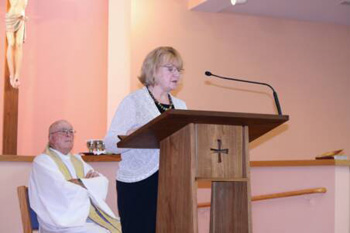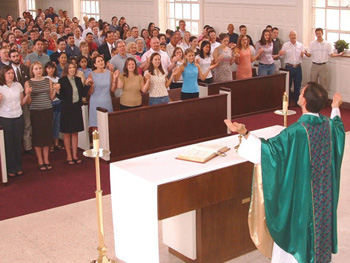All Present Are Considered to Be Celebrants
Folded chasubles continued a long liturgical tradition of the Church - credit to
New Liturgical Movement
To sum up: the ancient tradition of folded chasubles
disappeared officially from the liturgy in Holy Week 1956 (1) and from
the rest of the Liturgical Year in 1960.
Before their suppression, folded chasubles had enjoyed a high profile in the liturgy, being worn for a considerable portion of the Liturgical Year:
Before their suppression, folded chasubles had enjoyed a high profile in the liturgy, being worn for a considerable portion of the Liturgical Year:
- The Sundays and ferias of Advent and Lent (except Gaudete and Laetare Sunday and Christmas Eve);
- Palm Sunday, Ash Wednesday, Good Friday and the rest of Holy Week (except on Maundy Thursday and during the blessing of the Paschal Candle and the Mass of Holy Saturday);
- The Vigil of Pentecost before Mass;
- Ember Days (except those in the Octave of Pentecost);
- Candlemas during the blessing of candles and the procession. (2)
In an interesting aside, the liturgical historian, Fr. Josef Braun, S.J., noted in 1914 that folded chasubles first went out of use among some deacons and sub-deacons in Germany at the beginning of the 20th century. (3) In other words, Germany, the seed bed of the Liturgical Movement, led the way in abandoning them.
A dropped stitch
The excuse given for discarding the folded chasuble was that the Church could drop “outmoded” symbolism so as to set free the “inner spirit” of penance and make it more accessible to modern man. But destroying outward forms that had been consecrated by centuries of Tradition, far from liberating the spirit that inspired those forms, caused both loss of form and spirit – as a visit (not recommended) to a modern day Novus Ordo would amply confirm.
By its deliberate decision to abandon the folded chasuble, Pius XII’s Commission pitted itself not only against the authority of Tradition, but also against a symbol of those core values to which priests during many centuries had given their allegiance. Its abolition by Pius XII in the 1956 Holy Week reform was only one strand in a far wider fabric of measures, which would later be adopted by the reformers to eliminate traditions that made visible and apparent key concepts of the priesthood. Like a dropped stitch in a knitted garment, the loss of the folded chasuble caused some essentials of priestly spirituality to begin to unravel.
From this, we can see the gravity of discarding a tradition that had for centuries been a significant element in the Roman Rite. The fact that both Mgr. Gromier himself and the folded chasubles about which he spoke with great pride are now regarded as curious remnants of the Church’s ancient past, and of no importance to modern times, is a telling example of the long-term effects of the Holy Week reforms.
The priest's role fades
It was a startling innovation when the 1951 Ordo instructed the priest to sit and listen to the reading of the Prophecies at the Easter Vigil rather than perform the traditional role of reciting them himself at the altar while they were being chanted by other ministers. This was, initially, only optional and ad experimentum.

Women and other lay people replaced the priest in reading the Epistle & the Gospel
The duplication of Scripture readings – read quietly by the celebrant while chanted simultaneously by other ministers – was, and still is, regarded among progressives with horror as at best a “useless repetition” and, at worst, “illogical.”
But that is because their sensus catholicus has been negatively influenced by the liturgical reforms insofar as they no longer understand the fundamental doctrinal principle underlying the custom of “duplication,” which involves the nature and purpose of the biblical readings in the liturgy.
A forgotten reminder
Before 1956, the obligation for the celebrant to read the Scriptures in the liturgy was a symbolic reminder that he was not (as commonly thought today) conducting a Bible reading session for the instruction of the faithful. He wore a chasuble (discarded in the reformed rite) because the biblical readings, including the Easter Vigil Prophecies, were a part of the Mass of which he was the celebrant.
His proximity to the altar was an outward sign that the words he was reading came from the Word, the Second Person of the Holy Trinity, Who is made present on the altar at the Consecration. The point of the symbolism was, therefore, to visually reinforce the correlation between Scripture and the Eucharist and, crucially, the priest’s interconnecting role in both.

All those present at Mass are now considerd co-celebrants
For an answer, we need look no further than the demands of the Liturgical Movement to foster a more “communitarian” approach to the liturgy in which all present are considered to be celebrants. A consistent theme at all the major Liturgical Congresses of the 1950s, from Maria Laach to Assisi, (6) was that the first part of the Mass should be conducted in choro, i.e., with the priest away from the altar, and that he should not “monopolize” all the readings.
A new liturgical principle established
Pius XII’s 1956 ruling to re-allocate the celebrant’s role to other ministers for the Holy Week ceremonies may seem of little significance in the wider scheme of things. But to dismiss that reform as unworthy of concern is to overlook the elephant in the sanctuary.
That this reform was the start of a systematic encroachment of the priest’s ministerial role in the liturgy, and was accompanied by a steady escalation of lay “active participation”, is evident from what it brought in its train. For, this early deviation from tradition established a new principle that would receive its ultimate affirmation in the adoption of a Protestant-style “Liturgy of the Word” in the Novus Ordo. Here, the priest is permanently detached from the altar in the first part of the Mass, while the readings are done at a lectern in the vernacular, preferentially by anyone except the celebrating priest.
To be continued
- This was further confirmed by the contemporary reformer, Fr. F. McManus, in his Ceremonies of Holy Week, 1956, p. 48, note 4. The suppression applied to the folded chasuble and, by inclusion, the broad stole in both of its traditional colors: violet for penitential days and black for Good Friday.
- See A. Fortescue, Ceremonies of the Roman Rite Described, 1920, p. 254.
- Josef Braun, “ln Allemagna la planeta plicata non si usa più.” in I paramenti sacri : loro uso, storia e simbolismo (Sacred Vestments: their use, history and symbolism), translation G. Alliod, Torino, Marietti, 1914, p. 96.
- Ordo Sabbati Sancti Quando Vigilia Paschalis Instaurata Peragitur, ‘De Lectionibus’, 1956, n. 15 “Celebrans et ministri, clerus et populus, sedentes auscultant” (The celebrant and his ministers, the clergy and the people, sit and listen).
- The 1960 Rubrics: § 473 “In sung Masses, all that the deacon, or sub-deacon, or lector sing or read by virtue of their office is omitted by the celebrant.”
- See Part 21: "Liturgical Anarchy Increases under Pius XII"
